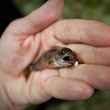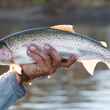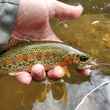I could have marked the rock hump with GPS, or even a simple bleach-bottle buoy. But this was a family vacation to the Wisconsin Northwoods, not a fishing trip, and my kit was bare-bones: an 8-weight rod, a box of bugs, a couple spools of leader material. When I spotted the pair of outsized smallmouth—I was poking around under a high midday sun in the aluminum rowboat that came with our cottage—I had to go Old School to be sure I’d find my way back when the lake glassed off that evening.
Triangulation, it’s called. Remember that? A white boathouse, a lightning-scarred pine, and the wreckage of a duck blind gave me landmarks to reckon by, and when I rowed out after supper a swell of anticipation rose in my chest with each pull of the oars. The lake, as I’d hoped, had gone mirror-smooth. I anchored with the reddening sun at my back, knotted a chartreuse Dahlberg Diver to my leader, greased it up, and began slinging casts. A loon yodeled from a nearby bay, raising the hair on the back of my neck.
Bent like a heron, eyes glued to that quiff of day-glo deerhair and rod pointed straight at it, I worked the fly in short glugs with my line hand, pausing to let the ripples settle before twitching it again, the bug submerging briefly then bobbing to the surface ...
Ker-pow!
Or maybe it was Ka-boom! It’s a commentary on my misspent youth, I suppose, that a heavy smallmouth blowing up on a bug always conjures comic-book shorthand. It points up the fact, too, that among smallmouth guides, who have to get their kicks when and where they can, it’s all about the “eat.”
Those of us lucky enough to be attached to one of these brawlers also savor the next part: the slugfest that bends your stick to the corks and threatens to put your rod arm in traction. On this occasion, sadly, the smallmouth scored a first-round TKO. The instant the bass felt the hook it erupted from the water in a torquing leap and, just that fast, came unstuck. The fish gave me enough of a look, though, to establish its generous dimensions—and make me grumpily second-guess my decision to use a barbless fly.
The conventional wisdom in the smallmouth camp, its northern chapter in particular, is that the best topwater fishing comes early—May through mid-June, roughly. Or, to pin it down more precisely, just before and after the spawn. The bass are in the shallows then, making them more accessible to surface presentations and at times even affording the chance to sight-cast to them.
As the summer waxes and the water warms, the smallmouth drift into deeper lies. This is when a lot of flyfishers, assuming that the window of topwater opportunity has closed, stow their bugs and poppers for the season—and deprive themselves of some of the most explosive action of the year.
The person who opened my eyes to this was Wendel Dafcik. The co- proprietor, with his brother Kurt, of Crow Rock Lodge on Ontario’s Lake of the Woods—a fabulous smallmouth destination, FYI—Wendel was my early mentor in the art and science of bass-bugging.
“Mid- to late-summer is my favorite time to fish topwater,” he insisted. “You typically get a lot of warm, still, stable weather then, and under those conditions the smallmouth really orient to the surface. The ‘big boys’—the 3-, 4-, and 5-pounders—get active then, too.”
All true—but it’s vitally important at this time of year that you pick your spots. Bugging during the middle of the day is just sweaty casting practice; better to focus your efforts on the early morning hours and, especially, the two-to-three hours before sunset. That’s when the bass, invigorated by the cooler water and emboldened by the lower light, move up to prowl the rocky points, reefs, and shorelines. A few bulrushes or lily pads sweeten the pot; ditto the presence of any kind of woody structure.
These fish are hunting aggressively, and they’re not choosy. When that bug or popper gurgles into view and trips the smallmouth’s predatory trigger, all hell breaks loose.
That’s another thing about late-summer smallies: They fight like demons. Their stamina having ramped up to match their punching power, the same bass that in May or June would have given you just enough of a tussle to suggest what it’s capable of will now plain wear you out. A springtime smallmouth is a sparring partner; a summer smallmouth is a beast.
I’ve been talking about stillwater smallmouth here, but while river smallies are a somewhat different animal they, too, get fatter, fitter, and more responsive to topwater presentations as the summer progresses. They’re also affected just as positively by stable weather patterns—maybe more so.
The leader and hook point both checked out, so I swished the bug in a tube of fly-dry, shook off the excess crystals, and waited. A brood of half-grown mergansers skittered through the reeds in front of the ruined blind. The evening air was tightening and I buttoned my shirt at the throat.
After a while I stood up and started casting again. The fish I’d stung was unlikely to return but maybe his partner would give me a whirl.
He did. This time, despite a display of acrobatic leaps and bruisingly powerful rushes that left me shaking my head in awe, the hook held. The tape
read 19 inches—about 4½ pounds. I gave him one last admiring look before slipping him back into the water.
I rowed to the cottage in deepening twilight. A pair of loons were calling now, playing question-and-answer in voices as old as time.
































Comments
Thomas G Williams replied on Permalink
Good read, thanks!
Pages